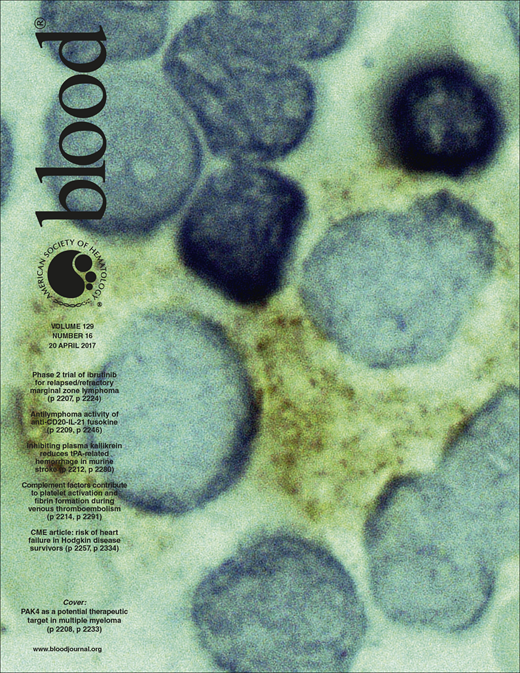A 66-year-old woman was investigated for persistent anemia over the past few years. A complete blood count showed: leukocytes, 10.00 × 109/L; hemoglobin, 96 g/L; mean corpuscular volume, 88.8 fL; and platelets, 447 × 109/L. The blood film showed normocytic anemia without blasts. The marrow aspirate was normocellular with 3% blasts; there was megakaryocytic dysplasia with monolobated megakaryocytes (panel A; bar represents 1.00 mm, Wright-Giemsa stain) and normal granulopoiesis. Erythropoiesis was dysplastic, including poor hemoglobinization, budding nucleated red blood cells, and internuclear bridging (panel B, red arrow; bar represents 1.00 mm, Wright-Giemsa stain). The biopsy was normocellular with increased monolobated/hypolobated megakaryocytes without erythroid hypoplasia (panel C; original magnification ×40, hematoxylin and eosin stain). Cytogenetics showed 46,XX,del(5)(q15q35)[9]/46,XX[1] (panel D, red arrow). A diagnosis of myelodysplastic syndrome (MDS) with isolated del(5q) or refractory cytopenia with multilineage dysplasia (RCMD) with del(5q) was debated, because RCMD could have internuclear bridging and del(5q). The patient was doing well with occasional transfusions at 18 months after the initial diagnosis.
MDS with isolated del(5q) has typical dysplastic monolobated/hypolobated megakaryocytes. Internuclear bridging, often with genetic material losses/gains, is rare, but can be observed in all subtypes of MDS, including del(5q). The 2016 World Health Organization revision updated the criteria of MDS with isolated del(5q), which includes 1 additional cytogenetic abnormality except −7 or del(7q) besides the del(5q), and uses this new criteria as an exclusion criterion for some subtypes of MDS, such as RCMD, now called MDS with multilineage dysplasia.
A 66-year-old woman was investigated for persistent anemia over the past few years. A complete blood count showed: leukocytes, 10.00 × 109/L; hemoglobin, 96 g/L; mean corpuscular volume, 88.8 fL; and platelets, 447 × 109/L. The blood film showed normocytic anemia without blasts. The marrow aspirate was normocellular with 3% blasts; there was megakaryocytic dysplasia with monolobated megakaryocytes (panel A; bar represents 1.00 mm, Wright-Giemsa stain) and normal granulopoiesis. Erythropoiesis was dysplastic, including poor hemoglobinization, budding nucleated red blood cells, and internuclear bridging (panel B, red arrow; bar represents 1.00 mm, Wright-Giemsa stain). The biopsy was normocellular with increased monolobated/hypolobated megakaryocytes without erythroid hypoplasia (panel C; original magnification ×40, hematoxylin and eosin stain). Cytogenetics showed 46,XX,del(5)(q15q35)[9]/46,XX[1] (panel D, red arrow). A diagnosis of myelodysplastic syndrome (MDS) with isolated del(5q) or refractory cytopenia with multilineage dysplasia (RCMD) with del(5q) was debated, because RCMD could have internuclear bridging and del(5q). The patient was doing well with occasional transfusions at 18 months after the initial diagnosis.
MDS with isolated del(5q) has typical dysplastic monolobated/hypolobated megakaryocytes. Internuclear bridging, often with genetic material losses/gains, is rare, but can be observed in all subtypes of MDS, including del(5q). The 2016 World Health Organization revision updated the criteria of MDS with isolated del(5q), which includes 1 additional cytogenetic abnormality except −7 or del(7q) besides the del(5q), and uses this new criteria as an exclusion criterion for some subtypes of MDS, such as RCMD, now called MDS with multilineage dysplasia.
For additional images, visit the ASH IMAGE BANK, a reference and teaching tool that is continually updated with new atlas and case study images. For more information visit http://imagebank.hematology.org.

![A 66-year-old woman was investigated for persistent anemia over the past few years. A complete blood count showed: leukocytes, 10.00 × 109/L; hemoglobin, 96 g/L; mean corpuscular volume, 88.8 fL; and platelets, 447 × 109/L. The blood film showed normocytic anemia without blasts. The marrow aspirate was normocellular with 3% blasts; there was megakaryocytic dysplasia with monolobated megakaryocytes (panel A; bar represents 1.00 mm, Wright-Giemsa stain) and normal granulopoiesis. Erythropoiesis was dysplastic, including poor hemoglobinization, budding nucleated red blood cells, and internuclear bridging (panel B, red arrow; bar represents 1.00 mm, Wright-Giemsa stain). The biopsy was normocellular with increased monolobated/hypolobated megakaryocytes without erythroid hypoplasia (panel C; original magnification ×40, hematoxylin and eosin stain). Cytogenetics showed 46,XX,del(5)(q15q35)[9]/46,XX[1] (panel D, red arrow). A diagnosis of myelodysplastic syndrome (MDS) with isolated del(5q) or refractory cytopenia with multilineage dysplasia (RCMD) with del(5q) was debated, because RCMD could have internuclear bridging and del(5q). The patient was doing well with occasional transfusions at 18 months after the initial diagnosis. / MDS with isolated del(5q) has typical dysplastic monolobated/hypolobated megakaryocytes. Internuclear bridging, often with genetic material losses/gains, is rare, but can be observed in all subtypes of MDS, including del(5q). The 2016 World Health Organization revision updated the criteria of MDS with isolated del(5q), which includes 1 additional cytogenetic abnormality except −7 or del(7q) besides the del(5q), and uses this new criteria as an exclusion criterion for some subtypes of MDS, such as RCMD, now called MDS with multilineage dysplasia.](https://ash.silverchair-cdn.com/ash/content_public/journal/blood/129/16/10.1182_blood-2016-11-752204/4/m_blood752204f1.jpeg?Expires=1764365691&Signature=aqR9CX3tF1exh1WC4XKMml0bGRorRVLe1KbVWlRypfGYodAOtq6wTGz0Qngt9yQYE3kaElhZ79Qt~CdMysjI8bxuYGtDuGwwMAhKLW4K0hJm--Sh7tzN14M3KpudhNWfsF5sQDUjFOfvRfi~Xcqvb2bvJxmuL-Y3fN3G98eEmXmkfeZdV5cgGl-1faN2aSDlJOc~OvmviyGMIiWEsS8fG5ddmx0qM8j6HdJ9v7S2PES357-xBfkHohpb9UhUcbP8WNZWGZoNfEr4tx1~mgbwdZfA76oAuOfn0AwL2CA6I8ol2ahv1NACRYWX6-jkDsLhCpTOLjZmwYVMn0VuEaztdw__&Key-Pair-Id=APKAIE5G5CRDK6RD3PGA)
